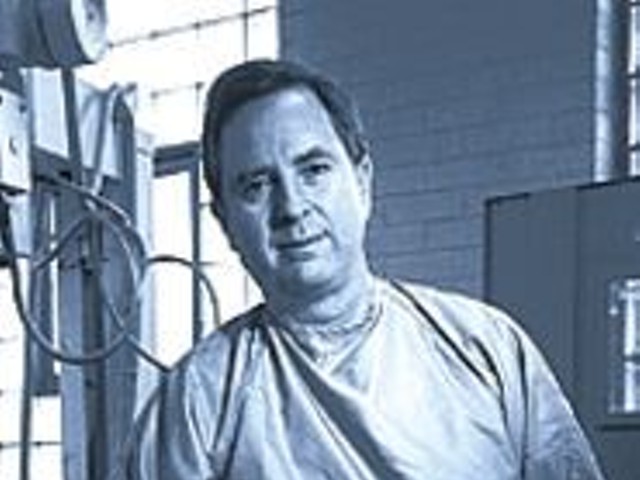"I've lived here my whole life," says Manley, "and I always knew this was the big make-out spot. So when we read about this being the final night, I told him, 'We have to go before it closes.'" Hadland gives her a little squeeze, and she cuddles closer.
"It's its own little city," says Manley, looking out on the runway, which is lit up like a pinball machine.
"I'm from Vegas, and this is not a lot of lights to me," counters Hadland.
A jumbo jet thrusts off the runway and sails past. "These things go over your head, it's almost like you could reach up and touch them," Manley says. "It makes you contemplate everything, all these people going places -- I can't believe they have so many places to go."
The airplane-watchers gather on a small asphalt parking lot in North County. Some stay in their cars; some mill around. There is a general ease of movement, a sort of calculated idling about, not unlike travelers taking a break at a highway rest area. At one end of the lot, kids chase each other around a car, giggling wildly. One family sets up a telescope.
It's the perfect night for the end of an era. In the clear western sky, all five planets visible to the naked eye -- Mercury, Venus, Mars, Jupiter and Saturn -- are clustered, a celestial event that occurs only once every twenty to 30 years. The phenomenon has been building for three weeks, and tonight, Tuesday, May 14, is the planets' tightest grouping.
The next morning, the Lambert Airport public viewing area, for 40 years located at North Lindbergh Boulevard and Missouri Bottom Road, will be closed. The small parking lot, a mecca for young lovers, dreamers and flight buffs, will be engulfed by construction in a project that will expand the airport from 2,162 to 3,730 acres.
Don't worry, it's only temporary, says airport director Colonel Leonard Griggs Jr. "For many St. Louisans, their introduction to aircraft and air travel came as children, when their parents and grandparents brought them to Lambert to watch airplanes take off and land," Griggs says. "The viewing area is a St. Louis tradition that we're definitely going to preserve." It won't be in the same location, however. Lambert spokesman Mike Donatt says a new viewing area will debut sometime after the airport expansion is completed, but he cannot say exactly when that will happen or where on the airport complex it will be.
The jargon of an air traffic controller crackles from a scanner: "Southwest 1485, cross three-four and proceed to gate ... clear for takeoff and change over to departure frequency." When the takeoff comes, all eyes turn to the east. The plane picks up speed as it rolls down the runway, and necks crane as the thing lifts off, a scant 200 hundred yards from the viewing area, passing just overhead and gaining altitude but still low enough for spectators to read the nomenclature on its belly. You hear a few ooohs and ahhhs as the aircraft passes, and then folks go back to what they were doing.
Mark Fox, a regular at the lot, isn't taking the final night of his favorite haunt very well. "I'm very sorry to see it go," says Fox, 43. "Very few cities have something like this." The president of an injection-molding plant in Fenton, Fox has been coming out once a week for years. It's his way of relaxing: "It's almost like a retreat. It's neat to go some place where all the stress is on somebody else. The guys in the towers have all the worries."
Unlike the more casual observers, Fox likes being on the inside of what's happening on the runway. With the purchase of a scanner, he's become a dedicated eavesdropper, listening in on dialogue between pilots and the tower. "It makes it a lot neater when you know what they're doing out there," Fox says. "It's almost like watching a game of chess, the way controllers move planes in and out."
Using the scanner and binoculars, Fox can usually pinpoint which aircraft the controllers are readying for takeoff. "Each flight has a specific flight number," he explains, "and when you're listening to the tower, you'll hear the controller say, for example, 'American 2720, cross runway twelve right.' When you see one of the planes start to move right, then you know that's the flight he was talking to." Because Fox looks like a serious airplane-watcher, it's not unusual to find bystanders around his green van. "Most come over to talk because I have the scanner and they want to listen in," he says. If they're lucky, they may get to hear some big-league choreography in progress on the part of the controllers. "Every once in a while they have 'oopsies,'" says Fox. "When two approaching planes come too close, one has to back off, and the tower has to decide which one."
Airplane-watchers -- if they're anything like NASCAR fans, half-expecting violent thrills -- must be content with small events such as Fox's "oopsies," because major accidents at Lambert, with 1,400 daily flights -- takeoffs and landings -- are few and far between. The last one occurred on Thanksgiving 1994, when a TWA aircraft hit a small corporate jet on the runway, killing two on the smaller craft.
Charlene Robinson, another regular, echoes Fox's reason for frequenting the viewing lot -- in fact, sometimes she's there twice a day. "I get relaxation watching planes," she says. "You get to know the different types of planes, and just experiencing them taking off and landing is great, especially when they take off and land on the same runway at the same time. You can feel the vibrations. It's exhilarating. You just want to go on a trip somewhere."
Robinson, who works for a title company, says she sometimes comes to the lot at lunchtime and again in the evening. The previous evening, she came out with her husband; they had dinner and watched planes. Now, in the setting sun, she sits behind the wheel of her car, consulting tables and jotting numbers on forms. This is her routine, what she does between planes.
Not even Lambert's public-relations department can say for sure when the public viewing area on Lindbergh was installed; the best guess is the mid- to late 1960s. This outdoor vantage point overlapped an earlier viewing area inside the terminal that existed from 1956-78. That one extended like a balcony some 100 yards out on what was actually the roof of the B concourse. It was said to be an excellent spot from which to view planes.
Alex Gottschalk has brought his own planes -- a model of Air Force One and another of the MD-90, the last aircraft McDonnell Douglas designed before merging with Boeing -- to the viewing area. Alex, two-and-a-half years old, keeps a tight grip on his planes, and he holds them up in a kind of salute every few minutes as their full-sized counterparts roar overhead. "He talks about airplanes all the time," says Alex's dad, Matt Gottschalk. "I wouldn't be surprised if he became a pilot or joined the Air Force when he grows up."
Matt Gottschalk works for Boeing as a planner for the C-17 cargo plane. Until last year, Boeing, adjacent to Lambert, had its own viewing area. "Before September 11, employees and their families could watch planes at the plant, but now everyone's got to have a badge," he says. This place is the next best thing. "I haven't been here since I was a kid, but just in the last few months I've been bringing these guys," he says, referring to Alex and his baby brother.
As the sun begins to dip below the horizon, the runway lights become more defined, shimmering strands of blue, red, yellow and white gems. A plane approaches the runway from the east. Closer, closer. For a several long seconds it seems to be suspended, just hanging there like some monstrous bird. Then there's a little puff of smoke as the tires hit the tarmac. Touchdown.
"We used to bring the kids out here when they were babies," says Jim Kalkbrenner, events manager at the Missouri Botanical Garden. "They would sit and stare. And then we read in the paper it was closing, so we thought we'd come out one more time." At the moment, his wife and their two children are setting up a picnic on the grass beyond the cordon. Kalkbrenner's daughter, in a long white dress, looks almost surreal against the field of vivid green. "I grew up in Chicago, and you can't get this close to O'Hare," Kalkbrenner continues. "It's amazing to see the Air National Guard when they take off in tandem in their F-15s."
Both Fox and Robinson say they will still come out and park instead on the outer road at the end of the runway, just down an embankment from the old viewing area. In fact, a few cars are parked there now. But that place won't be as good, says Fox, who has already tried it out. "Because the parking is on the side of road, most of them will just keep to themselves in their own vehicle. The camaraderie just won't be there."
They may not have been regulars, but his family will also miss the lot, Kalkbrenner says: "It's just a place where you could park and relax. There's nothing negative about it. But chalk up another St. Louis institution lost to progress. It's like that old Joni Mitchell song -- 'You don't know what you've got till it's gone.'"





